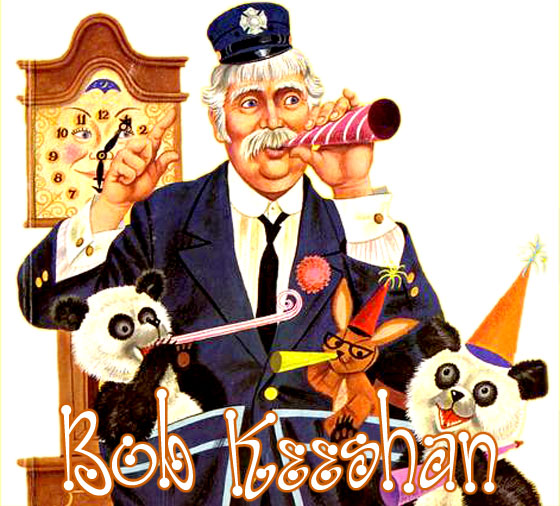
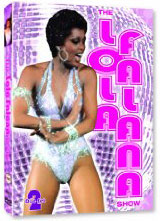
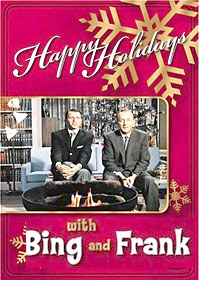
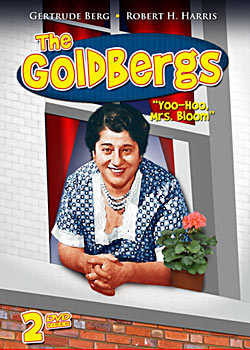
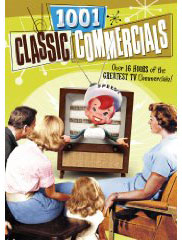
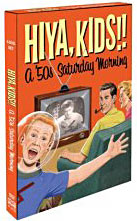
 |
 |
 |
 |
 |
 |
|
TV
Shows on DVD/ / / /
/ / / Punk Book / /
/ / / / / Holiday
Specials on DVD / /
/ / / / Classic
Commercials |
||||||
|
INTERVIEW WITH BOB KEESHAN
But on this day, a Saturday in November in 1996, Keeshan stood alone, without costume or character. He was visiting Denver as part of a tour promoting his newest book, "Good Morning Captain: 50 Wonderful Years With Bob Keeshan: TV's Captain Kangaroo." Hundreds of fans would wait patiently for a chance to talk with Keeshan, ask him for an autograph or to pose with them, and recount stories of what he meant to them growing up.
Outside of our own families, my wife and I had not told anyone she was pregnant with our first child: a daughter, Madeline, who would be born in June 1997. But something prompted me to tell Keeshan my news, which delighted him. During the years of "Captain Kangaroo" and after it left the airwaves, first on CBS and then on PBS, Keeshan developed into an advocate for children. He offered me an excellent piece of advice: Read to your child every day. Not too long after my hour-long interview with Keeshan, a package arrived in the mail. It was a copy of "Books to Grow By," a reference guide Keeshan published in early 1996 of what books are best for children.
The three interviews have been combined into the following piece, which is intended to provide as complete a historical record as possible into Keeshan’s life and career, including his never-realized plans to return to television. He was hoping to produce a children’s program called "The Captain and the ZooZoo Crew" in the years before his death. Keeshan died in 2004 at age 76.
A: It was a pleasure. Always happy to hear that. Q: I enjoyed your book. I actually read both of yours. I read "Growing Up Happy," which was a very good book, and I read this one this week. It’s wonderful to see these pictures. A: Yeah, it is. It’s kind of a nice book. It was wonderful to do. The reaction to it has been a lot of fun too. Q: It seems, after reading the two books over a course of a few weeks, that "Growing Up Happy" (full title: "Growing Up Happy: Captain Kangaroo Tells Yesterday's Children How to Nurture Their Own," published in 1989) was much more serious. Was it a conscious effort to keep this a little bit lighter? A: Yes. I think that’s the nature of this book. The other one was biographical but much more personally biographical. This book is much more fun, you’re absolutely right, and really designed to elicit good solid memories, good positive memories of people who grew up with the program. There’s probably somewhere around 220 million grew up with the Captain in some way or another. About the only exceptions are those who grew up in another culture and have come to this country in recent years. "Growing Up Happy" was much more biographical and much more a nurturing book; if you recall the subtitle of that book was "Captain Kangaroo Tells Yesterday’s Children How to Nurture Their Own," so that’s much more a useful book. A lot of people have expressed the opinion it was a very valuable book to them in nurturing their children, and that was really the intent of that book. Quite different from the intention of this book, which is to, in a nostalgic way, recall happier times.
A: Well, I don't think I was just an actor. I was the executive producer and everything funneled through me. In the very beginning, everything went through me. Obviously, the Captain's personality is me, is my own personal feelings and philosophy. So all of that is as much a part of the program as any actor might be. It's obviously more than that. Q: Was there a point early on when you wanted to stop and do other things? A: I never had that Shakespearean disease. Never had the desire to do something else. It's been a very busy time. I did six hours of programming every week for most of the time. That kept us tremendously busy, particularly producing and editing it and I had a very big hand in writing it. I was serious about it. I am serious about it. I'm serious about families and children. I'm an advocate. I spend a lot of time public speaking on behalf of children and issues concerning young people. I just left the National Association of Children's Hospitals board last year after fulfilling my constitutional limit of six years. I've always been involved in children's issues and family issues. This has been a serious enterprise. It's not just a children's show that I did. Not at all.
A: That was probably a great blessing, really. In the very beginning the program staff was populated by young parents, so a lot of our programming was intuitive at that time because we probably wrongly assumed that most families were in the same situation as ours. We certainly did not think about other families that were not in as good a position as we were. We were people who were not worrying about food on the table and poverty and everything else, which were existent then, not to the extent that they are today in families in the richest nation in the world. But we felt that we did understand what it was to be a parent with young children. Then, as time went on, we did bring aboard child professionals in various disciplines, child psychologists and educators and others whose function really was to teach us about the needs of children. So we really had a seminar going for 30-some odd years from some of the best child professionals available. It was very useful to us because then we would take that information, whether we were writers or producers or actors, we would then take that information and translate it creatively into the work that we were doing. That was very positive.
A: No, because they were kept away from the show right from the beginning. We really never made much of a big deal of it. We never used them as a laboratory, we never questioned them. They may have watched it, they may not have watched it. We never asked them. The community was very respectful of our wishes. The schools never made a big deal of it. As a result, they lived a very, very normal childhood. Q: There were so many different characters on "Captain Kangaroo" and so many different segments, how did it all get put together? A: Well, at different times in different ways. The show really crossed the boundaries of a lot of changes in television, particularly technical and production changes. So the putting together of the show was done differently at different times. When we first went on the air in 1955 we were live and so there were limitations to that. There were also benefits from it. There was a wonderful spontaneity to it. But things happen. We actually did two shows a day Monday through Friday. We would do one at 8 o’clock for the Eastern Time Zone and in 40 seconds turn everything around and at 9 o’clock did the show all over again.
A: The same show, all over again, for the Central Time Zone and the Mountain Zone. Then through a terrible, terrible process called kinescope the show was shown on the West Coast. Then tape came along. That was one development. Tape made it possible for us really to do the show pretty much as we always had done it, because we couldn’t edit tape in the very beginning, or we could but literally it could take an hour to make one single edit so we just didn’t do it. So it was basically a live show that was taped, and California got the live show but with a better technical version. Then as time went by it became easier to edit. Digital editing came along. So it was not only easy to edit, there were all kinds of effects that could be achieved. The production values changed considerably as a result of all this and ultimately we were doing the show more like they do motion pictures and television because we would 3 minutes here and a minute and a half there and we could always do a 20-second segue. All of this came together in the editing suite. We could mix and match shows. We could take, for example, we could do a story a fairy tale of some kind or our interpretation of a fairy tale which would require large sets maybe and guests and so on. Expenditures which we could never have afforded when it was done just for the one live show. But now because we were able to tape it and edit it and perfect it, it went into the library. That might then be amortized over 12 runs over three years or something of that sort. All of those things, there are hundreds of details of that nature that changed the way the program was done. Q: How long would it take to do one show? A: As opposed to doing a show in one hour straight in the live days, we did the show in pieces. So it was done in maybe 25 different pieces. Or there might be 20 pieces and there might be four pieces from another day, so there’s no way to say it took us an hour. It actually took us a lot longer to do each show in total than it did when we were live and that’s because we were doing more ambitious programming. The production was much more ambitious. That was not possible in live days.
A: Bunny Rabbit and Mr. Moose and Grandfather Clock, Dancing Bear — how many of those characters were there from the beginning? A: Well, Bunny was there from the beginning and Mr. Green Jeans of course was there from the beginning, as was the Captain. Mr. Moose came along about year two. Dancing Bear maybe year three. They were all there pretty much in the early days. There were a lot of other characters that were introduced over those years that even I forget at this point that didn’t work out, so we abandoned them.
A: That’s a good example really of how accidentally
things come along. We had a meeting and we were listening to a record
that we’d just received. Believe it or not, it was a record, not
a tape or a CD, but it was a record called the "Dancing Bear."
We just sat around and said how do we do this? Somebody said how about
Gus in a bear suit? Gus being Gus Allegretti. Gus said, "Yeah, I’m
game," and so we had a nice bear suit made that Gus crawled into.
It was not a lot of fun but he is a great talent. Then we just had him
dance to this record, the "Dancing Bear," and that was that.
Then we got mail. A lot of people said oh, we love that dancing bear.
Let us see him again. So we repeated the number but then we also started
writing other material for him. We made him a character on the show and
within a year or so he was a very well established character on the program.
Bunny Rabbit just came along in the beginning. Mr. Green Jeans, we didn’t
create Mr. Green Jeans, he [Lumpy Brannum] did. It was his own personal
character. It represented everything that he felt strongly about. The
environment and animals. He was of course by background a musician, a
very good one, and played for Fred Waring for 16 years prior to coming
to our show. But he had had an avocation. He had a small farm in Pennsylvania
and tended his garden. He was tied to the earth. He was tied to animals.
And that was just his personality, which we took full advantage of, which
turned Mr. Green Jeans very much in that direction.
A: Oh, sure. It’s a constant ongoing process. Absolutely. Q: Were there things that you thought would work well and you were wrong? A: Oh, sure, all the time. Probably much more than the ones that made it. Now you’re going to ask like what? I don’t remember most of them. You forget them. Q: You forget your failures. A: Yeah. Well, you don’t forget your failures. It’s just that you remember your successes. Because successes are around and they’re there and they become important to the program and what they do becomes important to the program whereas a failure’s maybe on the program four or five times when we realized it wasn’t working and that’s that. You don’t really remember them very well. Not that you intentionally try to forget them out of embarrassment or whatever, but there’s nothing to remember about them except they didn’t work.
A: Tom Terrific came on very early, probably a year or so
into the program. One of our agreements with CBS was that they would supply
us with animation and it was animation that we would approve. We went
through everything that was available. They had just bought Terrytoons
and had the whole Terrytoons library so they felt very comfortable.
A: Yeah. Completely inappropriate. So we said we can’t find anything here. And they agreed with us. They looked at and they agreed with us. They said that’s not what you should be using. Why don’t you do your own? So we went to Terrytoons and they were the producers. A terrific guy who was one of my writers, Gene Wood, was assigned to the task and Gene and a bunch of the other people devised this character, Tom Terrific, and other characters, Mighty Manfred the Wonder Dog and the villains, Pittsburgh the Pirate and Isotope Feeney. Gene wrote the storylines and actually lived at Terrytoons and supervised the production of it. That’s how Tom Terrific came into being.
A: It was really a technical thing. It was live and it gave us three and a half or four minutes of relief to regroup ourselves. Animation, as we had envisioned it originally, would have been about a third of the program material and as it actually turned out it was probably less than a tenth of the program material. But it gave us the physical relief in doing the show. Q: At what point did you realize that Captain Kangaroo would be a successful show? A: I thought it was great from the first minute of the first
day. I was prejudiced. I thought we had a very different and new approach
to programming for young people and if we remained faithful to our principles
of catering to the intelligence and potentially good taste of the child
then we had an opportunity to do some very, very good programming. I was
probably one of the few that thought it would really make it because it
was nonconventional. It did break a lot of rules. It wasn’t the
commercial venture that most programming was then and it wasn’t
one-tenth the commercial venture that most children’s programming
is today.
A: Oh, no. Not at all. It wouldn’t get on the air
today. We once, I forgot what year it was, somewhere in the ‘60s,
we did a "Carol Burnett Show" and Carol played the part of a
network executive and I played myself. I was coming in and making a presentation.
She was wonderful, of course, as she is.
READ PART TWO OF THIS See Also: Rare
Interview with Captain Kangaroo - Bob Keeshan |
Captain Kangaroo: Bob Keeshan Mr. Green Jeans: Hugh Brannum Debbie: Deborah Weems Dennis: Cosmo Allegretti Mr. Baxter: James E. Wall Mr. Moose See Also: Captain Kangaroo History More on Captain Kangaroo Captain Kangaroo Books & Toys
TOM TERRIFIC Tom Terrific's main villain was Crabby Appleton, that mean old man who did everything that he could to ruin the fun of many kids and to make poor Tom and Manfred's lives miserable. Luckily for all of us our two heroes foiled this miserable. fink and taught him the hard way that crime doesn't pay. The late Lionel Wilson did the voices for "TT". Tom Terrific didn't last too long on Captain Kangaroo, the films were eventually replaced by Lariat Sam and later by The Undersea Adventures of Captain Nemo, the Toothbrush Family, Ludwig, and The Adventures of Simon In The Land of Chalk Drawings. Mr. Keeshan did the narrations for the Simon cartoons, the original narrator for the British version of the films was character actor Bernard Cribbins. - Kevin S. Butler TV on DVD/ /Holiday Specials on DVD TV Commercials on DVD TV Shows on BLU-RAY |
 |
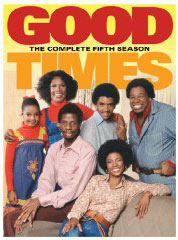 |
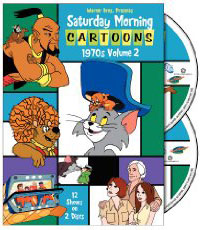 |
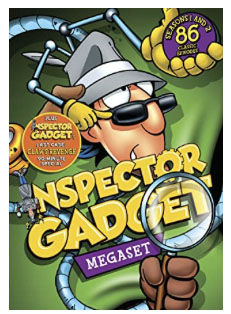 |
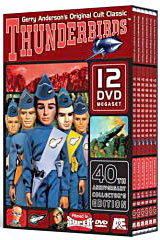 |
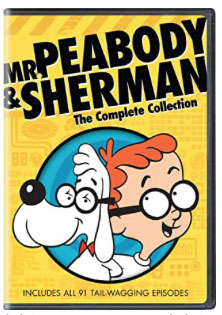 |
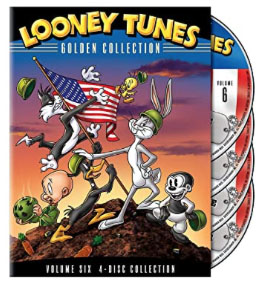 |
|
TV
Shows on DVD/ / / /
/ / / Punk Book/ /
/ / / / / Punk Book/ / / / / / / Holiday
Specials on DVD / /
/ / / / Classic
Commercials / / / / / TV
Shows on DVD Reviews |
|||||||
|
||||||||||||||